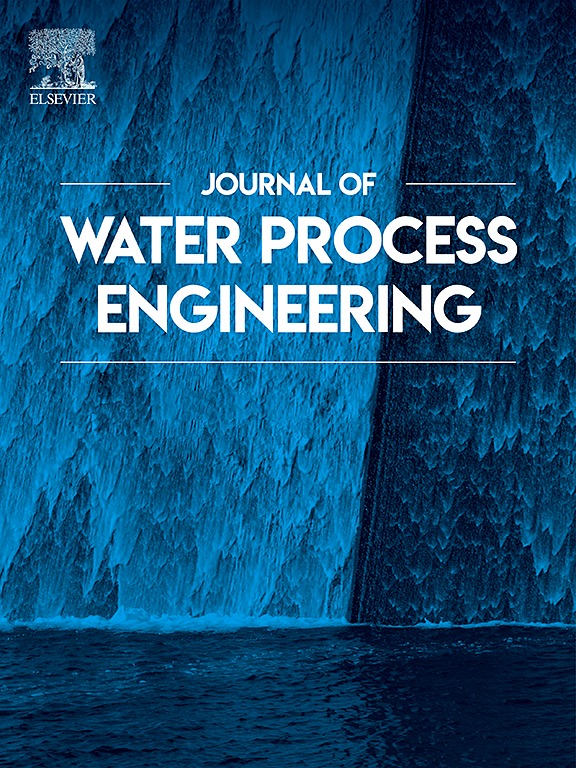Leveraging naturally low pH for enhanced 2,4-dichlorophenoxyacetic acid removal from industrial wastewater: Carbon black adsorption and resource recovery approach
IF 6.3
2区 工程技术
Q1 ENGINEERING, CHEMICAL
引用次数: 0
Abstract
A sustainable approach for treating 2,4-dichlorophenoxyacetic acid (2,4-D) in acidic industrial wastewater was investigated by leveraging its naturally low pH characteristics. The adsorption performance of bare carbon black (CB) under acidic conditions was evaluated in comparison with 3-aminopropyltriethoxysilane (APTES)-modified CB, while exploring the integration of waste-derived sodium hydroxide (NaOH) for final pH adjustment. The results showed that optimal 2,4-D removal was achieved by bare CB at pH 2, aided by hydrogen bonding, electrostatic interactions, and Lewis acid–base interactions working synergistically. At pH 2, the maximum sorption capacity of 14 mg/g was observed at an optimal CB dose of 4.5 g/L. While APTES-modified CB at pH 4 had a 3.63-times higher sorption capacity, our life-cycle assessment revealed that utilizing bare CB under naturally acidic conditions coupled with waste-derived NaOH reduced the global warming potential by 27 % compared to using APTES-modified CB with fresh NaOH. This reduction primarily resulted from avoiding energy-intensive modification processes and utilizing waste-derived chemicals. The approach also decreased operational costs by 35 %. The adsorption process followed the Freundlich isotherm and pseudo-second-order kinetic models, indicating multi-layer adsorption and chemisorption mechanisms. This research demonstrates that integrating naturally occurring acidic conditions with waste-derived materials can enhance both environmental and economic sustainability in treating industrial wastewater under challenging pH conditions, supporting circular-economy principles in wastewater treatment.

利用自然低pH增强工业废水中2,4-二氯苯氧乙酸的去除:炭黑吸附和资源回收方法
利用酸性工业废水中2,4-二氯苯氧乙酸(2,4- d)的天然低pH特性,研究了一种可持续处理方法。通过与3-氨基丙基三乙氧基硅烷(APTES)改性的裸炭黑(CB)在酸性条件下的吸附性能进行比较,并探讨了废液源氢氧化钠(NaOH)的整合对最终pH值的调节作用。结果表明,在pH为2的条件下,在氢键、静电相互作用和Lewis酸碱相互作用的协同作用下,裸CB去除2,4- d效果最佳。在pH为2的条件下,以4.5 g/L的最佳炭黑剂量,吸附量最大可达14 mg/g。虽然aptes改性的CB在pH为4时的吸附能力高出3.63倍,但我们的生命周期评估显示,在自然酸性条件下使用裸CB与废物产生的NaOH相结合,与使用aptes改性CB与新鲜NaOH相比,减少了27%的全球变暖潜能值。这种减少主要是由于避免了能源密集型的改性过程和利用废物衍生的化学品。该方法还将运营成本降低了35%。吸附过程符合Freundlich等温线和拟二级动力学模型,表明吸附机理为多层吸附和化学吸附。该研究表明,将自然发生的酸性条件与废物衍生材料相结合,可以提高在具有挑战性pH条件下处理工业废水的环境和经济可持续性,支持废水处理中的循环经济原则。
本文章由计算机程序翻译,如有差异,请以英文原文为准。
求助全文
约1分钟内获得全文
求助全文
来源期刊

Journal of water process engineering
Biochemistry, Genetics and Molecular Biology-Biotechnology
CiteScore
10.70
自引率
8.60%
发文量
846
审稿时长
24 days
期刊介绍:
The Journal of Water Process Engineering aims to publish refereed, high-quality research papers with significant novelty and impact in all areas of the engineering of water and wastewater processing . Papers on advanced and novel treatment processes and technologies are particularly welcome. The Journal considers papers in areas such as nanotechnology and biotechnology applications in water, novel oxidation and separation processes, membrane processes (except those for desalination) , catalytic processes for the removal of water contaminants, sustainable processes, water reuse and recycling, water use and wastewater minimization, integrated/hybrid technology, process modeling of water treatment and novel treatment processes. Submissions on the subject of adsorbents, including standard measurements of adsorption kinetics and equilibrium will only be considered if there is a genuine case for novelty and contribution, for example highly novel, sustainable adsorbents and their use: papers on activated carbon-type materials derived from natural matter, or surfactant-modified clays and related minerals, would not fulfil this criterion. The Journal particularly welcomes contributions involving environmentally, economically and socially sustainable technology for water treatment, including those which are energy-efficient, with minimal or no chemical consumption, and capable of water recycling and reuse that minimizes the direct disposal of wastewater to the aquatic environment. Papers that describe novel ideas for solving issues related to water quality and availability are also welcome, as are those that show the transfer of techniques from other disciplines. The Journal will consider papers dealing with processes for various water matrices including drinking water (except desalination), domestic, urban and industrial wastewaters, in addition to their residues. It is expected that the journal will be of particular relevance to chemical and process engineers working in the field. The Journal welcomes Full Text papers, Short Communications, State-of-the-Art Reviews and Letters to Editors and Case Studies
 求助内容:
求助内容: 应助结果提醒方式:
应助结果提醒方式:


